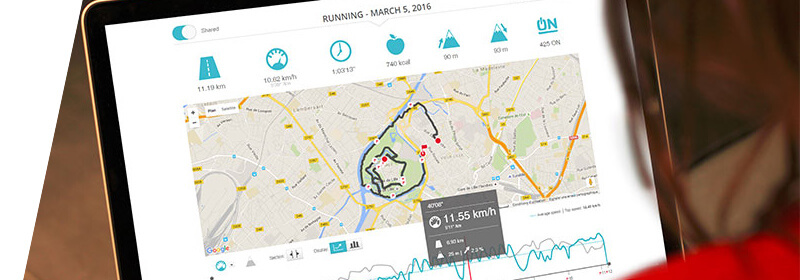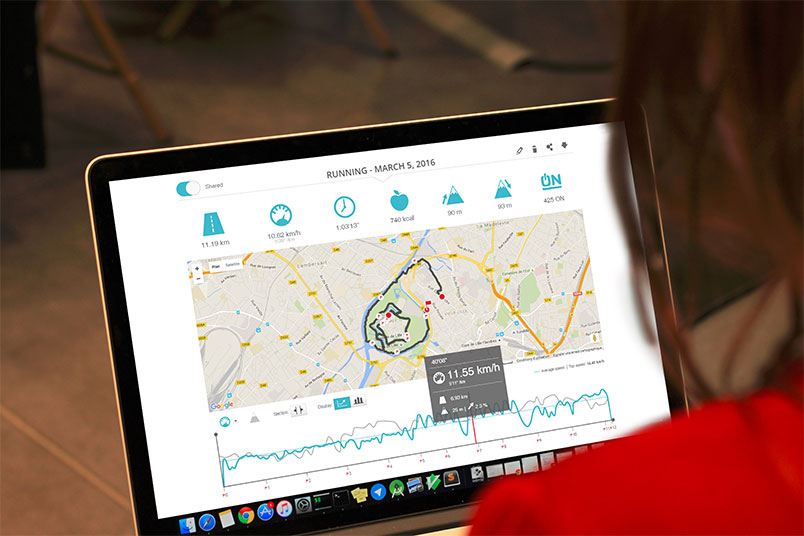The heart rate zones
With the heart rate belt Geonaute Bluetooth Smart, the connected crop top Kalenji or the connected T-shirt Kalenji, you can see your real-time heart rate, during your sessions with DECATHLON OCACH. A colored zones system helps you understand in which zone you are and you can train in.
Your heart rate is measured in bpm (beats per minute).The more intense your training, the faster your heart beats and so the higher your bpm value.The %cardio is a way of expressing the intensity of your effort, taking into account the characteristics of your heart.When your heart reaches its lowest cardio rate (rate at rest), you’re making no effort, so your %cardio is 0.When your heart reaches its maximum rate, your %cardio is 100.
The %cardio is sometimes called %HRmax for percentage of maximum heart rate.
By knowing your %cardio every moment you’re exercising, we can tell you what effort zone you’re in:
- Warm-up & Recovery,
- Fundamental endurance,
- Active endurance,
- Resistance,
- Heavy resistance.
Each zone corresponds to a different state of your body with its own benefits.You’ll find a description of each zone in the app.
To calculate your %cardio, we use the Karvonen formula:
%Cardio = (HR exercise - HR rest) / (HR max - HR rest)
Here is a description of each zone:
BLUE: WARM-UP / RECOVERY
50 to 60% of your %cardio
The blue zone represents moderate effort, ideal at the start of a session, to warm up gently, and at the end of a session to recover actively, eliminating waste produced by your muscles during exercise.
GREEN: FUNDAMENTAL ENDURANCE
60 to 70% of your %cardio
After 20 to 40 minutes in this zone, your muscles will begin to draw on your fat reserves. This moderate level of exercise will therefore allow you to tone your body while also improving your endurance for longer outings (more than 1½ hours). You can exercise within this zone for as long as you want!
YELLOW: ACTIVE ENDURANCE
70 to 80% of your %cardio
Effort is intense, but your body is able to provide enough oxygen to maintain this effort over time. Your muscles get used to consuming the sugar available in your muscle fibres more effectively. Thanks to this type of training, you can maintain a fast pace (e.g. 10 km race pace) for a longer period of time. However, this level of exercise should not be continued for more than 45 minutes without a break.
ORANGE: RESISTANCE
80 to 90% of your %cardio
In this zone, your body does not provide enough oxygen to cater for your muscles' needs: it is the anaerobic threshold. A training session involving short, repeated efforts within this zone will help to improve your performance over a given distance (e.g. your time for a 10 km race). You will also learn to recover more quickly from intense exercise. Each repeated resistance exercise should not exceed 5 minutes and the total time for these repetitions should not exceed 45 minutes.
RED: HEAVY RESISTANCE
> 90% of your %cardio
This zone means very intense effort. This type of training should only involve very short efforts with intervals in between (repetitions of 15 seconds to 2 minutes). The benefits are similar to those of the orange zone. But it helps to work on shorter exercises, which are easier for beginners to manage.
Your heart rate can be measured by any Bluetooth 4.0 heart rate monitor belt. Especially the Geonaute new generation heart rate monitor sensors built into Kalenji bras (for women) and T-shirts (for men).

